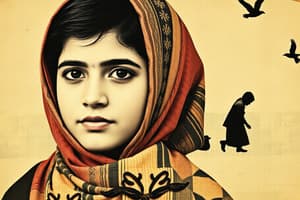Podcast
Questions and Answers
Considering the socio-economic context of Shangla as described, which of the following factors most critically underscores the challenges faced by women in accessing education and healthcare?
Considering the socio-economic context of Shangla as described, which of the following factors most critically underscores the challenges faced by women in accessing education and healthcare?
- The reliance on traditional games like hopscotch and cricket due to the lack of toys and books, hindering intellectual development from an early age.
- The scarcity of modern amenities such as hospitals and markets, coupled with the absence of clean water and electricity, exacerbating daily hardships. (correct)
- The preference for city-style clothing among girls, leading to social stigmatization and reduced opportunities for advancement.
- The prevalent celebration of cultural festivals like Small Eid, which diverts resources and attention from developmental needs.
In the context of male migration for labor and its impact on rural families discussed in the passage, what is the most far-reaching consequence for the women left behind, considering both economic and social dimensions?
In the context of male migration for labor and its impact on rural families discussed in the passage, what is the most far-reaching consequence for the women left behind, considering both economic and social dimensions?
- An enhanced ability to navigate societal norms regarding female visibility, circumventing restrictions on public engagement and interaction.
- A complete dependency on inconsistent remittances, coupled with heightened vulnerability due to potential abandonment and limited social agency. (correct)
- A transformation of domestic roles to include agricultural labor, resulting in greater economic independence and decision-making power within households.
- An increased engagement in traditional games and cultural activities, fostering community bonds and resilience in the absence of men.
Given the cultural emphasis on early marriage for girls in the described community, which intervention strategy would likely be the most effective in delaying or preventing child marriages, considering the interlinked socio-economic factors?
Given the cultural emphasis on early marriage for girls in the described community, which intervention strategy would likely be the most effective in delaying or preventing child marriages, considering the interlinked socio-economic factors?
- Providing conditional cash transfers to families who keep their daughters in school until a specified age linked to secondary education completion. (correct)
- Promoting awareness campaigns among young girls about the health risks associated with early pregnancy, empowering them to resist familial pressures.
- Establishing vocational training centers exclusively for married women, equipping them with skills to support their families post-marriage.
- Implementing strict legal sanctions against families who engage in child marriage, thereby creating a deterrent effect through fear of punishment.
Considering the narrative's emphasis on the limitations faced by women in accessing basic literacy, what is the ultimate insidiousness of illiteracy within the context of broader socio-economic disempowerment?
Considering the narrative's emphasis on the limitations faced by women in accessing basic literacy, what is the ultimate insidiousness of illiteracy within the context of broader socio-economic disempowerment?
Based on the description of the interviewee as ‘a somewhat sophisticated city girl’, what underlying assumption about urban versus rural identities is being subtly critiqued, even if unintentionally?
Based on the description of the interviewee as ‘a somewhat sophisticated city girl’, what underlying assumption about urban versus rural identities is being subtly critiqued, even if unintentionally?
Given the stark contrast presented between the interviewee’s experiences and the realities of rural life, what deeper societal fracture is amplified through her observations regarding educational disparity and gender inequality?
Given the stark contrast presented between the interviewee’s experiences and the realities of rural life, what deeper societal fracture is amplified through her observations regarding educational disparity and gender inequality?
Considering the interviewee's relative privilege and exposure, how might her narrative inadvertently contribute to the perpetuation of stereotypes regarding rural populations, despite her intent to highlight their challenges?
Considering the interviewee's relative privilege and exposure, how might her narrative inadvertently contribute to the perpetuation of stereotypes regarding rural populations, despite her intent to highlight their challenges?
In the context of limited resources and opportunities, what is the most critical mechanism perpetuating the cycle of disadvantage for women, particularly in terms of education and economic empowerment?
In the context of limited resources and opportunities, what is the most critical mechanism perpetuating the cycle of disadvantage for women, particularly in terms of education and economic empowerment?
Taking into account the confluence of factors—limited resources, patriarchal structures, and geographic isolation—that constrain opportunities for women, what represents the most strategically critical intervention point to catalyze systemic change within the described community?
Taking into account the confluence of factors—limited resources, patriarchal structures, and geographic isolation—that constrain opportunities for women, what represents the most strategically critical intervention point to catalyze systemic change within the described community?
In the context of the narrative, what is the broader implication of the mother's struggle to read prices in light of prevailing societal norms and power dynamics?
In the context of the narrative, what is the broader implication of the mother's struggle to read prices in light of prevailing societal norms and power dynamics?
Flashcards
Shangla
Shangla
A region in Pakistan where Malala grew up, characterized by poverty.
Small Eid
Small Eid
A festival marking the end of Ramadan, celebrated with feasts.
Traditional games
Traditional games
Games like hopscotch and cricket played by children in Shangla due to lack of toys.
Women's challenges in mountains
Women's challenges in mountains
Signup and view all the flashcards
Illiteracy among women
Illiteracy among women
Signup and view all the flashcards
Early marriage
Early marriage
Signup and view all the flashcards
Dependency on men
Dependency on men
Signup and view all the flashcards
Cultural expectations
Cultural expectations
Signup and view all the flashcards
Lack of amenities
Lack of amenities
Signup and view all the flashcards
Mother's struggle with literacy
Mother's struggle with literacy
Signup and view all the flashcards
Study Notes
Malala's Childhood Experiences
- Malala describes a rural, impoverished upbringing in Shangla, Pakistan.
- The family lacked modern conveniences like hospitals and markets, but celebrated festivals like Small Eid with large feasts.
- Food included chicken, rice, spinach, lamb, apples, cakes, and sweet tea.
- Malala's family put on a huge feast for her and her family when they visited.
Gender Roles and Limitations in the Region
- Women in the region faced significant limitations, including not having access to education (school).
- Many women couldn't read, and women had to hide their faces whenever they left their home, only able to talk to close relatives.
- Women couldn't have professional jobs like doctors.
- Men often left villages to work on road crews and in mines.
Cultural Differences and Social Norms
- Malala contrasted her experiences in a remote village with those who lived in cities and experienced modernization.
- Young girls didn't attend school and were considered a significant member of a family because of marriage.
- Many girls didn't go to school, including most of Malala's cousins.
- Parents prioritized marriage over education.
Personal Reflections
- Malala highlighted the hardship and emotional distress faced by her mother in trying to read.
- Malala was considered an educated city girl, but experiences in the village differed greatly.
- Malala found that villagers were less open to modernization because they were accustomed to a simple life.
Studying That Suits You
Use AI to generate personalized quizzes and flashcards to suit your learning preferences.




